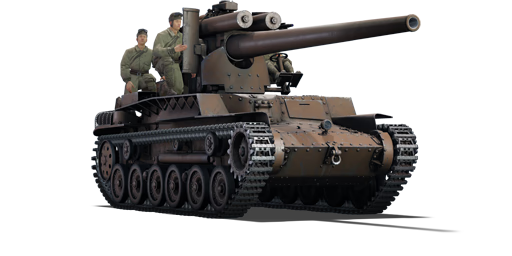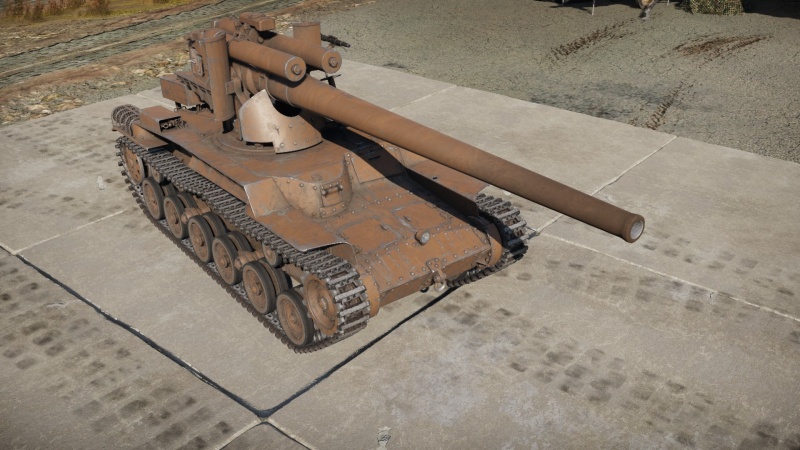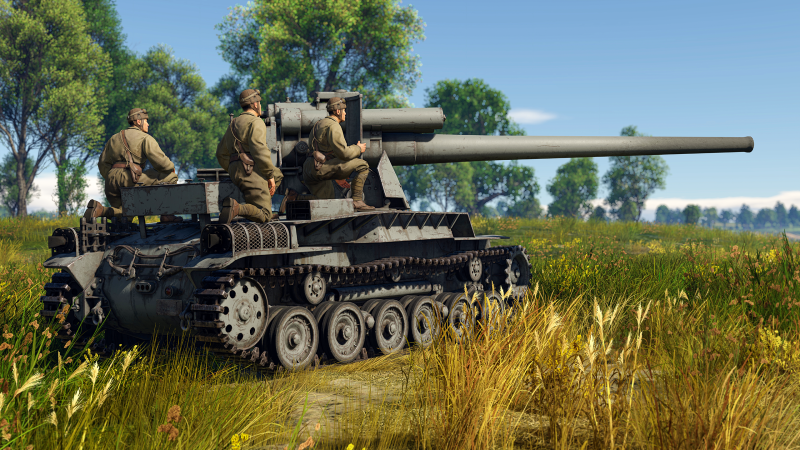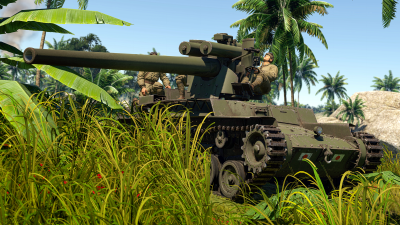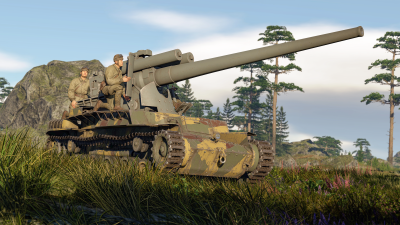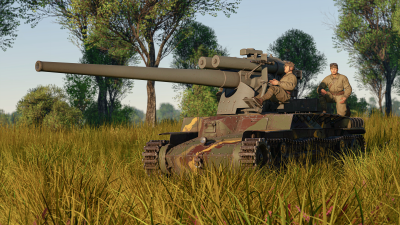Difference between revisions of "Chi-Ha LG"
m (Domestic Name) |
(→Description: Rework) |
||
| (14 intermediate revisions by 7 users not shown) | |||
| Line 1: | Line 1: | ||
{{About | {{About | ||
| about = Japanese medium tank '''{{PAGENAME}}''' | | about = Japanese medium tank '''{{PAGENAME}}''' | ||
| − | | usage = other | + | | usage = other versions |
| link = Chi-Ha (Family) | | link = Chi-Ha (Family) | ||
}} | }} | ||
| Line 11: | Line 11: | ||
== Description == | == Description == | ||
<!-- ''In the description, the first part should be about the history of the creation and combat usage of the vehicle, as well as its key features. In the second part, tell the reader about the ground vehicle in the game. Insert a screenshot of the vehicle, so that if the novice player does not remember the vehicle by name, he will immediately understand what kind of vehicle the article is talking about.'' --> | <!-- ''In the description, the first part should be about the history of the creation and combat usage of the vehicle, as well as its key features. In the second part, tell the reader about the ground vehicle in the game. Insert a screenshot of the vehicle, so that if the novice player does not remember the vehicle by name, he will immediately understand what kind of vehicle the article is talking about.'' --> | ||
| − | The '''{{Specs|name}} / Long | + | The '''{{Specs|name}} / Long 12 cm SPG''' ({{Annotation|長十二糎自走砲|Chō Jūni Senchi Jisōhō}}) was an obscure, one-off prototype discovered by US Marines at the Yokosuka Naval Arsenal, with little information available on its development. It was created by the {{Annotation|1st Section|Cannon & Artillery}} of the Imperial Japanese Navy Technical Department and assembled at Yokosuka. The vehicle was essentially a stripped-down Chi-Ha hull, modified with a metal platform extension to accommodate the gun crew, and fitted with a surplus 12 cm/45 10th Year Cannon, typically used on cruisers, carriers, or as coastal batteries. With little concrete development history, accounts from testing crews and US evaluations suggest the vehicle was at the limits of what the Chi-Ha hull could handle. All internal modules were removed except for the driver’s position, and the hull was reinforced with automotive steel to withstand the massive recoil of the gun—a force that would have otherwise destroyed a standard riveted Chi-Ha. The vehicle offered no real protection for the crew, leaving them entirely exposed. |
| + | |||
| + | It was introduced in [[Update "Raining Fire"]]. Despite being built on the Chi-Ha hull, this vehicle was not truly considered a tank, even within its limited development circle. Instead, it should be regarded as a mobile gun emplacement. The crew is entirely exposed, and the mobility is compromised due to the heavy gun. Sniping is the only viable strategy, with the need to retreat into cover after each shot to maximize survivability. The powerful 120 mm SAPCBC-HE shell, with a velocity of 825 m/s and penetration of 100 mm at approximately 300 meters, defines the Chi-Ha Long Gun as the epitome of a "glass cannon." However, after firing, the gun's severe recoil will likely knock it off target, requiring readjustment if it hasn't already destroyed its target. | ||
== General info == | == General info == | ||
| Line 17: | Line 19: | ||
{{Specs-Tank-Armour}} | {{Specs-Tank-Armour}} | ||
<!-- ''Describe armour protection. Note the most well protected and key weak areas. Appreciate the layout of modules as well as the number and location of crew members. Is the level of armour protection sufficient, is the placement of modules helpful for survival in combat? If necessary use a visual template to indicate the most secure and weak zones of the armour.'' --> | <!-- ''Describe armour protection. Note the most well protected and key weak areas. Appreciate the layout of modules as well as the number and location of crew members. Is the level of armour protection sufficient, is the placement of modules helpful for survival in combat? If necessary use a visual template to indicate the most secure and weak zones of the armour.'' --> | ||
| + | While it shares the hull of a regular Chi-Ha, the gun crew is almost completely exposed as the turret got removed in replacement of a naval gun. The gunshield itself is quite small and offers only protection against rifle calibre fire. | ||
| + | |||
| + | The best way of protecting the gun and keeping it operational is angling the gun itself when taking MG fire so that the gunner is always behind the breech, this will expose other gun crew but when taking close-range MG fire, there's not much else to do other than attempt to retreat while keeping the gun operational. | ||
'''Armour type:''' | '''Armour type:''' | ||
| Line 25: | Line 30: | ||
{| class="wikitable" | {| class="wikitable" | ||
|- | |- | ||
| − | ! Armour !! Front (Slope angle) !! Sides !! Rear | + | ! Armour !! Front (Slope angle) !! Sides !! Rear !! Roof |
|- | |- | ||
| − | | Hull || 25 mm || 25 mm | + | | Hull || 25 mm || 25 mm || 20 mm |
| + | ! | ||
|- | |- | ||
| − | | | + | | Gun shield || 10 mm ''Gun shield'' <br> 10 mm ''Gun mantlet'' |
| + | ! | ||
| + | ! | ||
| + | ! | ||
|- | |- | ||
|} | |} | ||
| + | |||
| + | '''Notes:''' | ||
| + | |||
| + | * Suspension wheels, tracks, and torsion bars are 15 mm thick. | ||
=== Mobility === | === Mobility === | ||
{{Specs-Tank-Mobility}} | {{Specs-Tank-Mobility}} | ||
<!-- ''Write about the mobility of the ground vehicle. Estimate the specific power and manoeuvrability, as well as the maximum speed forwards and backwards.'' --> | <!-- ''Write about the mobility of the ground vehicle. Estimate the specific power and manoeuvrability, as well as the maximum speed forwards and backwards.'' --> | ||
| + | While the hull and engine are the same, most non-essentials were scrapped from the Chi-Ha 12cm to reduce weight so the main gun wouldn't weigh an additional toll to the hull. After removing the turret, radio equipment, MGs and cuts in the hull, the tank comes down to almost the same weight of a regular [[Chi-Ha]] and hence performs the same. | ||
{{tankMobility|abMinHp=241|rbMinHp=150}} | {{tankMobility|abMinHp=241|rbMinHp=150}} | ||
| Line 41: | Line 55: | ||
=== Modifications and economy === | === Modifications and economy === | ||
{{Specs-Economy}} | {{Specs-Economy}} | ||
| + | |||
| + | As a glass-cannon sniper with hefty reload, modifications are down to personal preference, either get engine performance upgrades to get to a sniper spot sooner or get the gun upgraded so aiming it down on a target doesn't take too much time. | ||
== Armaments == | == Armaments == | ||
| Line 50: | Line 66: | ||
This gun shouldn't be confused with the one on the [[Chi-Ha Short Gun]], while said Chi-Ha has a short gun meant for transport ships on anti submarine & close range fire range, the 12cm/45 10th Year was used as coastal emplacements and outfitted on early Japanese cruisers. It offers a high velocity gun to fling HE over the map with quite an ease. | This gun shouldn't be confused with the one on the [[Chi-Ha Short Gun]], while said Chi-Ha has a short gun meant for transport ships on anti submarine & close range fire range, the 12cm/45 10th Year was used as coastal emplacements and outfitted on early Japanese cruisers. It offers a high velocity gun to fling HE over the map with quite an ease. | ||
| + | |||
| + | The 120mm cannon offers two ammunition types: a normal HE and an SAPCBC shot. It is highly recommended to only carry maximum SAPCBC, since you will need to make the 10 rounds count. besides, the SAPCBC has nearly the same equivalent of TNT in explosive filler, meaning that it will react the same way as HE upon hitting the groung or failing to pen. | ||
{| class="wikitable" style="text-align:center" width="100%" | {| class="wikitable" style="text-align:center" width="100%" | ||
| Line 68: | Line 86: | ||
==== Ammunition ==== | ==== Ammunition ==== | ||
| − | { | + | {{:10th Year Type (120 mm)/Ammunition|Ordinary Mod.1, C.P.(BF)}} |
| − | |||
| − | |||
| − | |||
| − | |||
| − | |||
| − | |||
| − | |||
| − | |||
| − | |||
| − | |||
| − | |||
| − | |||
| − | |||
| − | |||
| − | |||
| − | |||
| − | |||
| − | |||
| − | |||
| − | |||
| − | |||
| − | |||
| − | |||
| − | |||
| − | |||
| − | |||
| − | |||
| − | | Ordinary | ||
| − | |||
| − | |||
| − | |||
| − | |||
==== [[Ammo racks]] ==== | ==== [[Ammo racks]] ==== | ||
| Line 114: | Line 100: | ||
|- | |- | ||
|} | |} | ||
| − | Note: | + | '''Note''': |
* Shells are modeled individually and disappear after having been shot or loaded. | * Shells are modeled individually and disappear after having been shot or loaded. | ||
| Line 120: | Line 106: | ||
== Usage in battles == | == Usage in battles == | ||
<!-- ''Describe the tactics of playing in the vehicle, the features of using vehicles in the team and advice on tactics. Refrain from creating a "guide" - do not impose a single point of view but instead give the reader food for thought. Describe the most dangerous enemies and give recommendations on fighting them. If necessary, note the specifics of the game in different modes (AB, RB, SB).'' --> | <!-- ''Describe the tactics of playing in the vehicle, the features of using vehicles in the team and advice on tactics. Refrain from creating a "guide" - do not impose a single point of view but instead give the reader food for thought. Describe the most dangerous enemies and give recommendations on fighting them. If necessary, note the specifics of the game in different modes (AB, RB, SB).'' --> | ||
| − | + | With its powerful gun but lacking protection, the Chi-Ha LG should be played as a sniper. The good muzzle velocity and powerful shells (with up 1.7 kg of explosive filler) make it a threat for every vehicle. However, being able to carry only 10 shells is a disadvantage. Staying near captured points is ideal to refill your ammunition storage when necessary but it will expose you to artillery strikes. With its massive gun and gun breech, enemy tanks will likely target you first, so stay behind bushes or cover. Also, staying near buildings or trees will give the enemy planes a harder time to see you. Avoid open fields. With its open gun shield, armour is non existent. Even 7,92 mm machine guns can knock out the whole crew (only the driver is protected). When no machine guns or autocannons are used by the enemy, the Chi-Ha LG can get very survivable. If the enemy fires a shell at you, they will most likely hit the driver or one of the two loaders, leaving the rest of the crew alive. Despite having a 120 mm gun with good muzzle velocity, it only has 103 mm of penetration: that means the "point and click" option won't always work, you have to aim shots precisely. | |
| + | |||
| + | '''Enemies worth noting:''' | ||
| + | |||
| + | * [[M4A3 (105)]]: This low-rank Sherman has strong enough frontal armour, to withstand a 120 mm shell. Try shooting at the turret around the gun mantlet. It won't be easy, but a successful hit will reward you with a knock out. | ||
| + | * [[KV-1 (L-11)]]: This heavy tank could be a hard nut to crack for the LG if faced frontally. When the KV-1 is unangled, try to shoot the driver's port or the armour on the gun mantlet. When angled, shoot the armour near the gun mantlet only. | ||
=== Pros and cons === | === Pros and cons === | ||
| Line 129: | Line 120: | ||
* High shell velocity | * High shell velocity | ||
* Quick reload for a gun of its size | * Quick reload for a gun of its size | ||
| − | * The C.P.(BF) combines the penetration of APHE and the splash-damage capability of HE. The explosion of a non-penetrating hit to a cupola can wreck the roof | + | * The C.P.(BF) combines the penetration of APHE and the splash-damage capability of HE. The explosion of a non-penetrating hit to a cupola can wreck the roof armour of a tank |
* Versatile Chi-Ha chassis | * Versatile Chi-Ha chassis | ||
** Quite fast (up to {{Annotation|44 km/h|Arcade battles}} | {{Annotation|39 km/h|Realistic / Simulator battles}}), allowing it to get to certain spots in time | ** Quite fast (up to {{Annotation|44 km/h|Arcade battles}} | {{Annotation|39 km/h|Realistic / Simulator battles}}), allowing it to get to certain spots in time | ||
| Line 143: | Line 134: | ||
* 10 shells max | * 10 shells max | ||
* Ammunition is very exposed, one lucky shot can destroy the vehicle | * Ammunition is very exposed, one lucky shot can destroy the vehicle | ||
| − | * Shells might have some trouble penetrating the front | + | * Shells might have some trouble penetrating the front armour of some tanks, especially in uptiers |
== History == | == History == | ||
| Line 151: | Line 142: | ||
As the Chi-Ha was very structurally sound and is able to withstand high amounts of additional weights while maintaining stable stress-levels and speed. This made it a great testbed for heavier weapons and equipment. | As the Chi-Ha was very structurally sound and is able to withstand high amounts of additional weights while maintaining stable stress-levels and speed. This made it a great testbed for heavier weapons and equipment. | ||
| − | + | ;Design | |
One of these additions/variants was a Japanese Navy Construction Headquarters refit of the Chi-Ha to carry the [[120 mm/45 10th year type (120 mm)|12 cm/45 10th Year naval cannon]] at the end of the war. Information of the development of the Chi-Ha Long Gun is scarce but what is certain is that they were to be constructed in defence of the homeland in-case of the highly probable American invasion, target allied armour and reposition after being shown. | One of these additions/variants was a Japanese Navy Construction Headquarters refit of the Chi-Ha to carry the [[120 mm/45 10th year type (120 mm)|12 cm/45 10th Year naval cannon]] at the end of the war. Information of the development of the Chi-Ha Long Gun is scarce but what is certain is that they were to be constructed in defence of the homeland in-case of the highly probable American invasion, target allied armour and reposition after being shown. | ||
| Line 159: | Line 150: | ||
The crew consisted out of 5 people; the driver, tank commander, two gun crew, and an ammunition carrier. The cannon could elevate 20° and decline to -10°. Operating the cannon wasn't an easy task either due to the set-up of the gun on the plain back of the Chi-Ha. On top of the fire rate of 2 shells per minute, this would take a massive toll once in actual combat. | The crew consisted out of 5 people; the driver, tank commander, two gun crew, and an ammunition carrier. The cannon could elevate 20° and decline to -10°. Operating the cannon wasn't an easy task either due to the set-up of the gun on the plain back of the Chi-Ha. On top of the fire rate of 2 shells per minute, this would take a massive toll once in actual combat. | ||
| − | + | ;Usage | |
The first test took place in April of 1945 on mobility and firing. 30 shots were fired at varying distances with upgraded cannon sights, with the longest shot during the test being around 3 km. No discrete information about penetration capabilities were recorded or made it to the post-war reports. | The first test took place in April of 1945 on mobility and firing. 30 shots were fired at varying distances with upgraded cannon sights, with the longest shot during the test being around 3 km. No discrete information about penetration capabilities were recorded or made it to the post-war reports. | ||
| Line 168: | Line 159: | ||
=== [[wt:en/news/6840-development-chi-ha-long-gun-the-last-chance-gun-en|Devblog]] === | === [[wt:en/news/6840-development-chi-ha-long-gun-the-last-chance-gun-en|Devblog]] === | ||
| − | This curious prototype of a self-propelled gun was discovered in the territory of the Yokosuka naval base after Imperial Japan surrendered in WWII. The | + | This curious prototype of a self-propelled gun was discovered in the territory of the Yokosuka naval base after Imperial Japan surrendered in WWII. The 120 mm naval gun was installed on a turntable mounted to the chassis of a Type 97 Chi-Ha medium tank. It was obvious, that the self-propelled gun was assembled in a rush - the high losses of Japan in the final stages of WWII and a shortage of military production forced the army and naval commands to look for any way to protect the island metropolia of the Empire from the threat of an Allied landing. |
The self-propelled gun did not have any protection, the large calibre of the cannon and the weak platform of the medium tank presupposed firing mainly direct fire and in the rather limited arcs of forward and backward to avoid overturning due to the heavy recoil. Despite all these shortcomings, such vehicles were supposed to go into series for rapid deployment in dangerous sectors of the coastal defense line for the Japanese islands and firing at a line-of-sight distance at approaching enemy forces. | The self-propelled gun did not have any protection, the large calibre of the cannon and the weak platform of the medium tank presupposed firing mainly direct fire and in the rather limited arcs of forward and backward to avoid overturning due to the heavy recoil. Despite all these shortcomings, such vehicles were supposed to go into series for rapid deployment in dangerous sectors of the coastal defense line for the Japanese islands and firing at a line-of-sight distance at approaching enemy forces. | ||
| Line 178: | Line 169: | ||
;Skins | ;Skins | ||
| − | * [https://live.warthunder.com/feed/camouflages/? | + | * [https://live.warthunder.com/feed/camouflages/?vehicle=jp_navy_120mm_spg Skins and camouflages for the {{PAGENAME}} from live.warthunder.com.] |
| − | ;Images | + | |
| + | ;Images | ||
<gallery mode="packed" heights="150"> | <gallery mode="packed" heights="150"> | ||
File:Chi-Ha Long Gun (1).png| | File:Chi-Ha Long Gun (1).png| | ||
| Line 185: | Line 177: | ||
File:Chi-Ha Long Gun (2).png| | File:Chi-Ha Long Gun (2).png| | ||
</gallery> | </gallery> | ||
| + | |||
;Videos | ;Videos | ||
{{Youtube-gallery|GpCq7QDEjBk|'''The Shooting Range #220''' - ''Metal Beasts'' section at 00:28 discusses the {{PAGENAME}}.|-wIA6AuMBYo|Captured Experimental ''Long 12cm Chi-Ha''}} | {{Youtube-gallery|GpCq7QDEjBk|'''The Shooting Range #220''' - ''Metal Beasts'' section at 00:28 discusses the {{PAGENAME}}.|-wIA6AuMBYo|Captured Experimental ''Long 12cm Chi-Ha''}} | ||
| Line 194: | Line 187: | ||
;Related Development | ;Related Development | ||
| − | + | * [[Chi-Ha (Family)]] <small>(base hull)</small> | |
| − | |||
| − | |||
| − | |||
| − | |||
** [[Chi-Ha Short Gun|Type 97 Chi-Ha Short Gun]] <small>(another navy variant)</small> | ** [[Chi-Ha Short Gun|Type 97 Chi-Ha Short Gun]] <small>(another navy variant)</small> | ||
;Tanks of comparable role, configuration and era | ;Tanks of comparable role, configuration and era | ||
| − | + | * [[File:Sweden flag.png|30px|link=]] [[Pvkv II]] | |
| − | * [[ | + | * [[File:IJA flag.png|30px|link=]] [[Ro-Go Exp.]] |
| − | * [[ | + | * [[File:USSR flag.png|30px|link=]] [[ZiS-30]] |
| − | * [[ | + | * [[File:China flag.png|30px|link=]] [[LVT(A)(4) (ZiS-2)]] |
| − | * [[ | + | * [[File:Germany flag.png|30px|link=]] [[Dicker Max]] |
| − | * [[ | + | * [[File:USA flag.png|30px|link=]] [[M10 (Family)]] |
== External links == | == External links == | ||
<!-- ''Paste links to sources and external resources, such as:'' | <!-- ''Paste links to sources and external resources, such as:'' | ||
* ''topic on the official game forum;'' | * ''topic on the official game forum;'' | ||
| − | |||
* ''other literature.'' --> | * ''other literature.'' --> | ||
* [[wt:en/news/6840-development-chi-ha-long-gun-the-last-chance-gun-en|[Devblog] Chi-Ha Long Gun: The Last Chance Gun]] | * [[wt:en/news/6840-development-chi-ha-long-gun-the-last-chance-gun-en|[Devblog] Chi-Ha Long Gun: The Last Chance Gun]] | ||
| + | {{ShipManufacturer Yokosuka Naval Arsenal}} | ||
{{Japan tank destroyers}} | {{Japan tank destroyers}} | ||
Latest revision as of 17:29, 28 August 2024
| This page is about the Japanese medium tank Chi-Ha LG. For other versions, see Chi-Ha (Family). |
Contents
Description
The Type 97 Chi-Ha Long Gun / Long 12 cm SPG (長十二糎自走砲) was an obscure, one-off prototype discovered by US Marines at the Yokosuka Naval Arsenal, with little information available on its development. It was created by the 1st Section of the Imperial Japanese Navy Technical Department and assembled at Yokosuka. The vehicle was essentially a stripped-down Chi-Ha hull, modified with a metal platform extension to accommodate the gun crew, and fitted with a surplus 12 cm/45 10th Year Cannon, typically used on cruisers, carriers, or as coastal batteries. With little concrete development history, accounts from testing crews and US evaluations suggest the vehicle was at the limits of what the Chi-Ha hull could handle. All internal modules were removed except for the driver’s position, and the hull was reinforced with automotive steel to withstand the massive recoil of the gun—a force that would have otherwise destroyed a standard riveted Chi-Ha. The vehicle offered no real protection for the crew, leaving them entirely exposed.
It was introduced in Update "Raining Fire". Despite being built on the Chi-Ha hull, this vehicle was not truly considered a tank, even within its limited development circle. Instead, it should be regarded as a mobile gun emplacement. The crew is entirely exposed, and the mobility is compromised due to the heavy gun. Sniping is the only viable strategy, with the need to retreat into cover after each shot to maximize survivability. The powerful 120 mm SAPCBC-HE shell, with a velocity of 825 m/s and penetration of 100 mm at approximately 300 meters, defines the Chi-Ha Long Gun as the epitome of a "glass cannon." However, after firing, the gun's severe recoil will likely knock it off target, requiring readjustment if it hasn't already destroyed its target.
General info
Survivability and armour
While it shares the hull of a regular Chi-Ha, the gun crew is almost completely exposed as the turret got removed in replacement of a naval gun. The gunshield itself is quite small and offers only protection against rifle calibre fire.
The best way of protecting the gun and keeping it operational is angling the gun itself when taking MG fire so that the gunner is always behind the breech, this will expose other gun crew but when taking close-range MG fire, there's not much else to do other than attempt to retreat while keeping the gun operational.
Armour type:
- Rolled homogeneous armour (Hull)
- Structural steel (Gun breech and mount)
| Armour | Front (Slope angle) | Sides | Rear | Roof |
|---|---|---|---|---|
| Hull | 25 mm | 25 mm | 20 mm | |
| Gun shield | 10 mm Gun shield 10 mm Gun mantlet |
Notes:
- Suspension wheels, tracks, and torsion bars are 15 mm thick.
Mobility
While the hull and engine are the same, most non-essentials were scrapped from the Chi-Ha 12cm to reduce weight so the main gun wouldn't weigh an additional toll to the hull. After removing the turret, radio equipment, MGs and cuts in the hull, the tank comes down to almost the same weight of a regular Chi-Ha and hence performs the same.
| Game Mode | Max Speed (km/h) | Weight (tons) | Engine power (horsepower) | Power-to-weight ratio (hp/ton) | |||
|---|---|---|---|---|---|---|---|
| Forward | Reverse | Stock | Upgraded | Stock | Upgraded | ||
| Arcade | Expression error: Unexpected * operator. | 241 | Expression error: Unexpected round operator. | __.__ | |||
| Realistic | 150 | Expression error: Unexpected round operator. | __.__ | ||||
Modifications and economy
As a glass-cannon sniper with hefty reload, modifications are down to personal preference, either get engine performance upgrades to get to a sniper spot sooner or get the gun upgraded so aiming it down on a target doesn't take too much time.
Armaments
Main armament
This gun shouldn't be confused with the one on the Chi-Ha Short Gun, while said Chi-Ha has a short gun meant for transport ships on anti submarine & close range fire range, the 12cm/45 10th Year was used as coastal emplacements and outfitted on early Japanese cruisers. It offers a high velocity gun to fling HE over the map with quite an ease.
The 120mm cannon offers two ammunition types: a normal HE and an SAPCBC shot. It is highly recommended to only carry maximum SAPCBC, since you will need to make the 10 rounds count. besides, the SAPCBC has nearly the same equivalent of TNT in explosive filler, meaning that it will react the same way as HE upon hitting the groung or failing to pen.
| 120 mm 10th Year Type | Turret rotation speed (°/s) | Reloading rate (seconds) | |||||||||||
|---|---|---|---|---|---|---|---|---|---|---|---|---|---|
| Mode | Capacity | Vertical | Horizontal | Stabilizer | Stock | Upgraded | Full | Expert | Aced | Stock | Full | Expert | Aced |
| Arcade | 10 | -10°/+15° | ±60° | N/A | 8.80 | 12.19 | 14.80 | 16.37 | 17.41 | 13.00 | 11.50 | 10.60 | 10.00 |
| Realistic | 5.95 | 7.00 | 8.50 | 9.40 | 10.00 | ||||||||
Ammunition
| Penetration statistics | |||||||
|---|---|---|---|---|---|---|---|
| Ammunition | Type of warhead |
Penetration @ 0° Angle of Attack (mm) | |||||
| 10 m | 100 m | 500 m | 1,000 m | 1,500 m | 2,000 m | ||
| Ordinary, Mod.1 | HE | 25 | 25 | 25 | 25 | 25 | 25 |
| C.P.(BF) | SAPCBC | 103 | 102 | 95 | 87 | 80 | 74 |
| Shell details | ||||||||||||
|---|---|---|---|---|---|---|---|---|---|---|---|---|
| Ammunition | Type of warhead |
Velocity (m/s) |
Projectile mass (kg) |
Fuse delay (m) |
Fuse sensitivity (mm) |
Explosive mass (TNT equivalent) (kg) |
Ricochet | |||||
| 0% | 50% | 100% | ||||||||||
| Ordinary, Mod.1 | HE | 825 | 20.4 | 0.3 | 0.1 | 1.97 | 79° | 80° | 81° | |||
| C.P.(BF) | SAPCBC | 825 | 20.4 | 1.2 | 19 | 1.87 | 48° | 63° | 71° | |||
Ammo racks

| Full ammo |
1st rack empty |
Visual discrepancy |
|---|---|---|
| 10 | 1 (+9) | No |
Note:
- Shells are modeled individually and disappear after having been shot or loaded.
Usage in battles
With its powerful gun but lacking protection, the Chi-Ha LG should be played as a sniper. The good muzzle velocity and powerful shells (with up 1.7 kg of explosive filler) make it a threat for every vehicle. However, being able to carry only 10 shells is a disadvantage. Staying near captured points is ideal to refill your ammunition storage when necessary but it will expose you to artillery strikes. With its massive gun and gun breech, enemy tanks will likely target you first, so stay behind bushes or cover. Also, staying near buildings or trees will give the enemy planes a harder time to see you. Avoid open fields. With its open gun shield, armour is non existent. Even 7,92 mm machine guns can knock out the whole crew (only the driver is protected). When no machine guns or autocannons are used by the enemy, the Chi-Ha LG can get very survivable. If the enemy fires a shell at you, they will most likely hit the driver or one of the two loaders, leaving the rest of the crew alive. Despite having a 120 mm gun with good muzzle velocity, it only has 103 mm of penetration: that means the "point and click" option won't always work, you have to aim shots precisely.
Enemies worth noting:
- M4A3 (105): This low-rank Sherman has strong enough frontal armour, to withstand a 120 mm shell. Try shooting at the turret around the gun mantlet. It won't be easy, but a successful hit will reward you with a knock out.
- KV-1 (L-11): This heavy tank could be a hard nut to crack for the LG if faced frontally. When the KV-1 is unangled, try to shoot the driver's port or the armour on the gun mantlet. When angled, shoot the armour near the gun mantlet only.
Pros and cons
Pros:
- High shell velocity
- Quick reload for a gun of its size
- The C.P.(BF) combines the penetration of APHE and the splash-damage capability of HE. The explosion of a non-penetrating hit to a cupola can wreck the roof armour of a tank
- Versatile Chi-Ha chassis
- Quite fast (up to 44 km/h | 39 km/h), allowing it to get to certain spots in time
- Great turning ability in low gear
- Lovely climbing ability, Good to get in sniper locations
Cons:
- Gun shield is small and thin, doesn't provide too much cover
- Only one crew member is inside the tank
- Vehicle can be destroyed due low caliber MG fire even with full crew
- Two loader crew in the back of the tank have no direct cover
- 10 shells max
- Ammunition is very exposed, one lucky shot can destroy the vehicle
- Shells might have some trouble penetrating the front armour of some tanks, especially in uptiers
History
As the Chi-Ha was very structurally sound and is able to withstand high amounts of additional weights while maintaining stable stress-levels and speed. This made it a great testbed for heavier weapons and equipment.
- Design
One of these additions/variants was a Japanese Navy Construction Headquarters refit of the Chi-Ha to carry the 12 cm/45 10th Year naval cannon at the end of the war. Information of the development of the Chi-Ha Long Gun is scarce but what is certain is that they were to be constructed in defence of the homeland in-case of the highly probable American invasion, target allied armour and reposition after being shown.
Very slight changes took place with the most notable being the addition of a muzzle brake. The Chi-Ha would be simply used as a moving platform and hence all the default equipment from turret, hull machine gun, radio equipment and other interior pieces were stripped in exchange for ammo storage. The 12cm cannon was bolted on the hull and used similarly to the Archer in practice, firing from the rear to maintain recoil levels while firing.
The crew consisted out of 5 people; the driver, tank commander, two gun crew, and an ammunition carrier. The cannon could elevate 20° and decline to -10°. Operating the cannon wasn't an easy task either due to the set-up of the gun on the plain back of the Chi-Ha. On top of the fire rate of 2 shells per minute, this would take a massive toll once in actual combat.
- Usage
The first test took place in April of 1945 on mobility and firing. 30 shots were fired at varying distances with upgraded cannon sights, with the longest shot during the test being around 3 km. No discrete information about penetration capabilities were recorded or made it to the post-war reports.
While production plans were approved, no further vehicles beyond the prototype were recorded as being built or near completion by the end of the war.
The prototype recorded by the US was found with the Yokosuka 15th unit and is the only footage on said vehicle.
Devblog
This curious prototype of a self-propelled gun was discovered in the territory of the Yokosuka naval base after Imperial Japan surrendered in WWII. The 120 mm naval gun was installed on a turntable mounted to the chassis of a Type 97 Chi-Ha medium tank. It was obvious, that the self-propelled gun was assembled in a rush - the high losses of Japan in the final stages of WWII and a shortage of military production forced the army and naval commands to look for any way to protect the island metropolia of the Empire from the threat of an Allied landing.
The self-propelled gun did not have any protection, the large calibre of the cannon and the weak platform of the medium tank presupposed firing mainly direct fire and in the rather limited arcs of forward and backward to avoid overturning due to the heavy recoil. Despite all these shortcomings, such vehicles were supposed to go into series for rapid deployment in dangerous sectors of the coastal defense line for the Japanese islands and firing at a line-of-sight distance at approaching enemy forces.
Media
- Skins
- Images
- Videos
See also
- Related Development
- Chi-Ha (Family) (base hull)
- Type 97 Chi-Ha Short Gun (another navy variant)
- Tanks of comparable role, configuration and era
External links
| Yokosuka Naval Arsenal (横須賀海軍工廠) | |
|---|---|
| Destroyers (DD) | |
| Momi-class | IJN Momi |
| Light Cruisers (CL) | |
| Mogami-class | IJN Suzuya |
| Heavy Cruisers (CA) | |
| Myōkō-class | IJN Myoko |
| Battlecruisers (BC) | |
| Kurama-class | IJN Kurama |
| Amagi-class | IJN Amagi |
| Battleships (BB) | |
| Fusō-class | IJN Yamashiro |
| Nagato-class | IJN Mutsu |
| Tanks | Ka-Mi · Ka-Chi · Chi-Ha LG |
| See also | Yokosuka Naval Air Technical Arsenal |
| Japan tank destroyers | |
|---|---|
| Ro-Go Derivatives | Ro-Go Exp. |
| Chi-Ha Derivatives | Ho-Ni I · Ho-Ni III · Ho-Ro · Chi-Ha LG |
| Ho-Ri | Ho-Ri Prototype · Ho-Ri Production |
| Other | Na-To |
| JGSDF | |
| SPRG | Type 60 (C) |
| SPH | Type 75 · Type 99 |
| ATGM | Type 60 ATM |
| Rocket | Type 75 MLRS |
| USA | ▅M36 |


